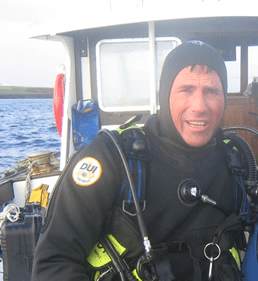
At What Depth Can You Get Decompression Sickness?

How deep can you dive before you have to decompress?
The depth at which you can get decompression sickness or the bends is more likely deeper than a dive to 5-6 metres (16-20 feet). But having said that, always take the same safety precautions no matter what the depth of your dive.
So at what depth can you get decompression sickness? How deep you dive before you can get decompression sickness is 6 metres (20 feet) or more. But factors such as the diver’s bodily composition (i.e. if they are obese) their fitness level, any medical conditions such as a hole in the heart, hydration, hard exercise on the dive and water temperature will affect this.
The best way to do more diving, but not necessarily decompression diving, is to book yourself on a scuba diving liveaboard. You can check the latest and best deals on liveaboards using the following window:
At what depth can you get decompression sickness in more detail?
In my opening sentience I use 6 metres (20 feet) as the cut-off for what depth you can get decompression sickness.
But having said that, decompression sickness (DCS) is such a random event. Almost any dive profile can result in DCS. Just because you’re diving at a shallow depth, don’t let this fool you into thinking you can’t get decompression sickness.
“Since DCI is a random event, almost any dive profile can result in DCI, no matter how safe it seems. The reason is that the risk factors, both known and unknown, can influence the probability of DCI in myriad ways. Because of this, evaluation of a diver for possible decompression illness must be made on a case-by-case basis by evaluating the diver’s signs and symptoms and not just based on the dive profile.”
Divers Alert Network – Decompression Illness: What Is It and What Is The Treatment?
When I was a member of a BSCA club in Saffron Walden in the UK, a club member who had a Ventricular Septal Defect or a hole in the heart managed to get decompression sickness symptoms diving in just 10 metres (30 feet) of water.
The symptoms she suffered were mild and in fact was a skin bend. However, this proves that you can even get decompression sickness on shallow dives too.
More Reading: What are the signs and symptoms of decompression sickness?
Diver safety at all times when it comes to depth and decompression sickness
You are therefore advised to take the usual precautions, no matter what the depth and length of your dive.
Dive to the appropriate dive tables or dive using your dive computer. Always ascend slowly, no matter whether you’re diving to 10 metres (30 feet) or to 40 metres (131 feet).

The depth you get decompression sickness is affected by many factors
There are many risk factors associated with decompression sickness. Some are known, whereas others are unknown.
Because of this, the depth of dive at which the risk of getting decompression sickness must be evaluated on a diver by diver basis. This means that a diver’s signs and symptoms of DCS may not just be based on the dive profile and depth of dive alone.
Whilst it’s known that a rapid ascent from a dive is closely linked to decompression sickness, as well as missing decompression stops, there are other factors at play too.
These other factors include the following:
- Obesity and fitness of the diver concerned.
- Dehydration or how hydrated the diver is before the dive.
- Hard exercise immediately after surfacing from a dive.
- Hard exercise at depth.
- Pulmonary disease, including Ventricular Septal Defect or a hole in the heart.
- The length of the dive.
- How cold the water is.
More Reading: 12 Decompression Sickness Risk Factors In Scuba Diving and How to Avoid Them
Decompression stops on dives
The shallower the dive, the less there’s going to be the chance of needing to carry out a decompression stop. On a dive to 10 metres (30 feet), you’re more likely to run out of air well before you need to carryout a decompression stop.
However, the deeper the dive, the more chance of running out of no decompression stop time, as the need to do decompression stops increases with depth.
A diver at 6 metres (20 feet) may be able to dive for many hours without needing to do decompression stops. But in comparison, a diver at 40 metres (130 feet), has around 12 minutes on no decompression stop time according to the PADI dive tables.
The risk of decompression sickness increases with depth and length of dive. So when you’re planning a deeper dive to more than 10 metres (30 feet), please bear this in mind.
But as a further safety precaution, always carry out a safety stop at between 5-6 metres (16-20 feet) at then end of every dive.
More Reading: How Deep Can You Dive Without Decompression (No Decompression Stop Limits)
I hope you enjoyed this article about at what depth can you get decompression sickness
I’d love to hear from you. Tell us about your adventures of diving and snorkeling, in the comments below. Please also share your photos. Either from your underwater cameras or videos from your waterproof go-pro’s!
If this article hasn’t answered all of your questions. If you have more questions either about snorkeling or scuba diving (or specifically on what at what depth can you get decompression sickness), please comment below with your questions.
There will also be many more articles about scuba and scuba diving safety tips (and on snorkeling too) for you to read and learn about this fabulous sport.
Have fun and be safe!
More Reading: Emergency Decompression Stop vs Safety Stop (What’s The Difference?)
